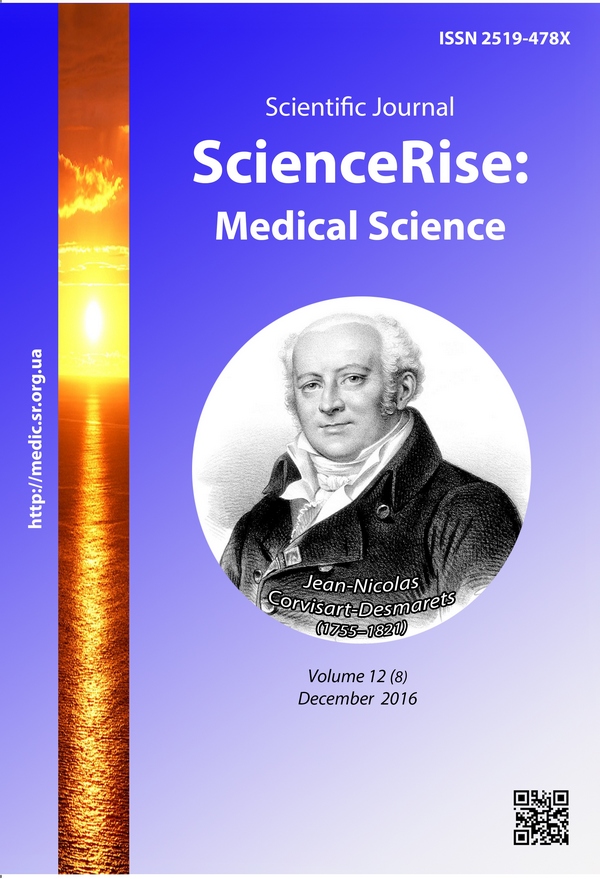The social and family functioning features of women with paranoid schizophrenia, with regard to their influence on mother-child interaction status
DOI:
https://doi.org/10.15587/2519-4798.2016.86541Keywords:
paranoid schizophrenia, social functioning, family functioning, mother, mother-child relationshipAbstract
Aim. To analyze the social and family functioning features of women with PS, with regard to their influence on mother-child interaction status.
Contingent and methods. During 2014–2016, 100 women with PS and 112 children of them (12 women had two children) were examined at psychiatric department of Zakarpattya oblast narcological dispensary. The women were aged from 25 to 40 years, duration of the disease was from 2 to 15 years. The children were aged from 3 to 14 years, 65 girls and 47 boys were among them.
The women were examined by clinical-psychopathological and psycho diagnostic methods; the children – by the “Kinetic family drawing” projection test.
Results. The signs of the social and family disfunctioning of mothers were found in the children’s pictures, in particular, actual family composition concealment in drawings, the absence of sick mother on drawings, the image of sick mother at the periphery of the picture, often by the real or assumed barriers, and "Virtual" mothers images, the absence of family members cooperative activities images, dominance of items, but not people in the drawings, too small images of themselves and family members, as a rule, at the bottom of a paper. These signs show a significant emotional discomfort, loneliness, depressed mood, inferiority feelings in the child, the lack of unity sense with the family, alienation feelings, an unsatisfied need to affiliate.
Conclusion. The obtained data were used as a basis for development of the system of medical and psychological optimization of mother-child interaction in women with PS
References
- Maruta, N. A., Kozhina, A. M., Korostij, V. I., Gajchuk, L. M. (2011). Zhizn' s shizofreniej. Chto delat'? Kharkov, 25.
- Psihicheskoe zdorov'e: usilenie bor'by s psihicheskimi rasstrojstvami (2010). Informacionnyj bjulleten' Vsemirnoj organizacii zdravoohranenija, 220, 12.
- Jur'eva, L. N. (2010). Shizofrenija: klinicheskoe rukovodstvo dlja vrachej. Kyiv: Sfera, 24.
- Tandon, R., Keshavan, M. S., Nasrallah, H. A. (2008). Schizophrenia: Just the Facts What we know. Schizophrenia Research, 100 (1-3), 4–19. doi: 10.1016/j.schres.2008.01.022
- Jur'eva, N. M. (2014). Gendernospecifіchna dezadaptacіja socіal'nogo funkcіonuvannja u zhіnok, hvorih na paranoidnu shizofrenіju: analіz fenomenu ta osoblivostі terapіi і psihosocіal'noi reabіlіtacіi. Ukrains'kij vіsnik psihonevrologіi, 22/2 (79), 139–146.
- Kosenko, R. (2014). Features of psychopharmacotherapeutic and psychotherapeutic constituents in the complex treatment of women with paranoid schizophrenia at different models of family interaction. Journal of Health Sciences, 04 (06), 43–56.
- Morvaniuk, A. V. (2014). Analysis of the general approach to psychotherapy and pharmacotherapy schizophrenia with gender differences in ukraine and the world. Journal of Health Sciences, 04 (01), 339–348.
- Buzdigan, O. G. (2016). Diferencіjovanі pіdhodi do psihosocіal'noi reabіlіtacіi hvorih na shizofrenіju z urahuvannjam klіnіko-funkcіonal'nih gendernih osoblivostej. Ukrains'kij vіsnik psihonevrologіi, 24/4 (89), 47–53.
- Kosenko, K. A. (2015). Psihosocіal'na reabіlіtacіja zhіnok, hvorih na paranoidnu shizofrenіju, pri rіznih modeljah rodinnoi vzaemodіi. Kharkiv, 24.
- Zhivotovs'ka, L. V., Kazakov, O. A., Borisenko, V. V. (2015). Analіz sіmejnogo zdorov'ja pri shizofrenіi v odnogo z bat'kіv. Medichna psihologіja, 10 (3), 48–51.
- Pshuk, N. G., Markova, M. V., Pshuk, E. Ja. (2012). Dinamіka resursu sіm’i, de prozhivae hvorij na paranoidnu shizofrenіju. Ukrains'kij vіsnik psihonevrologіi, 20/3 (72), 215.
- Markova, M. V., Dіhtjar, V. O. (2012). Rіven' funkcіonuvannja rodini jak kriterіj viboru tipu psihoterapevtichnogo vtruchannja v kompleksnomu lіkuvannі hvorih na paranoidnu shizofrenіju. Ukrains'kij vіsnik psihonevrologіi, 20/2 (71), 56–57.
- Plevachuk, O. Ju. (2011). Vzaemozv’jazok perebіgu shizofrenіi z psihologіchnimi osoblivostjami mіkroseredovishha pacіenta. Kharkiv, 18.
- Markova, M. V., Dіhtjar, V. O. (2010). Osoblivostі sіmejnoi vzaemodіi ta adaptacіi v rodinі u pacіentіv, hvorih na shizofrenіju, z tochki zoru psihoterapevtichnogo potencіalu sіm’i. Ukrains'kij vіsnik psihonevrologіi, 13/3 (64), 133–134.
- WHO Psychiatric Disability Assessment Schedule (WHO/DAS) with a Guide to its Use (1988). Geneva: WHO, 96. Available at: http://apps.who.int/iris/bitstream/10665/40429/1/9241561114.pdf
- Abramov, V. A., Zhigulina, I. V., Rjapolova, T. L. (2009). Psihosocial'naja reabilitacija bol'nyh shizofreniej. Donetsk: Kashtan, 584.
- Lutova, N. B., Makarevich, O. V. (2011). Tipologija otnoshenija sem'i k terapii psihotropnymi preparatami. St. Petersburg, 19.
- Olіfіrovich, N. І., Zіnkevich-Kuzemkіna, T. A., Velenta, T. F. (2006). Psihologіja sіmejnih kriz. Sankt-Peterburg: Rech', 360.
- Lapach, S. N., Chubenko, A. V., Babich, P. N. (2001). Statisticheskie metody v mediko-biologicheskih issledovanijah s ispol'zovaniem Ecxel: Jeksperimental'nye issledovanija. Klinicheskie ispytanija. Analiz farmacevticheskogo rynka. Kyiv: Morion, 407.
Downloads
Published
How to Cite
Issue
Section
License
Copyright (c) 2016 Майя Олександрівна Дрюченко

This work is licensed under a Creative Commons Attribution 4.0 International License.
Our journal abides by the Creative Commons CC BY copyright rights and permissions for open access journals.
Authors, who are published in this journal, agree to the following conditions:
1. The authors reserve the right to authorship of the work and pass the first publication right of this work to the journal under the terms of a Creative Commons CC BY, which allows others to freely distribute the published research with the obligatory reference to the authors of the original work and the first publication of the work in this journal.
2. The authors have the right to conclude separate supplement agreements that relate to non-exclusive work distribution in the form in which it has been published by the journal (for example, to upload the work to the online storage of the journal or publish it as part of a monograph), provided that the reference to the first publication of the work in this journal is included.









